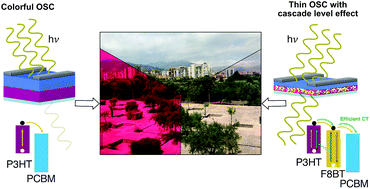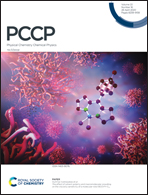Synergies and compromises between charge and energy transfers in three-component organic solar cells†
Abstract
In this paper, we developed different three-component organic heterojunction structures supported by PET/ITO substrates with the aim to study the possible synergies and/or compromises between charge transfer (CT) and energy transfer (ET) processes in organic solar cells (OSCs). As components, we employed poly(3-hexylthiophene-2,5-diyl) (P3HT; donor), [6,6]-phenyl-C61-butyric acid methyl ester (PCBM; acceptor) and poly(9,9-dioctylfluorene-alt-benzothiadiazole) (F8BT) that is known to give good ET to P3HT. At first, we observed that in a planar heterojunction (PHJ) solar cell, F8BT has to be properly located in between P3HT and PCBM to get a cascade energy level configuration allowing for a better CT and power conversion efficiency. Then, we observed that by producing a P3HT:F8BT blend, the energy transfer process can be improved in the P3HT:F8BT/PCBM active layer. This may enable decreasing the thickness of the active layer while maintaining a similar PCE that is very interesting for the development of transparent OSCs. However, the P3HT:F8BT blend limits the P3HT–PCBM CT with respect to a P3HT/F8BT/PCBM PHJ, showing that a compromise between CT and ET is needed to get a higher PCE or higher transparency. By the above approach, in this paper, we developed highly transparent heterojunction structures for solar cell devices with PCEs comparable to those observed from the colorful reference P3HT/PCBM PHJ solar cells on PET/ITO substrates.

- This article is part of the themed collections: 2020 PCCP HOT Articles and PCCP Editor’s Choice, 2020


 Please wait while we load your content...
Please wait while we load your content...